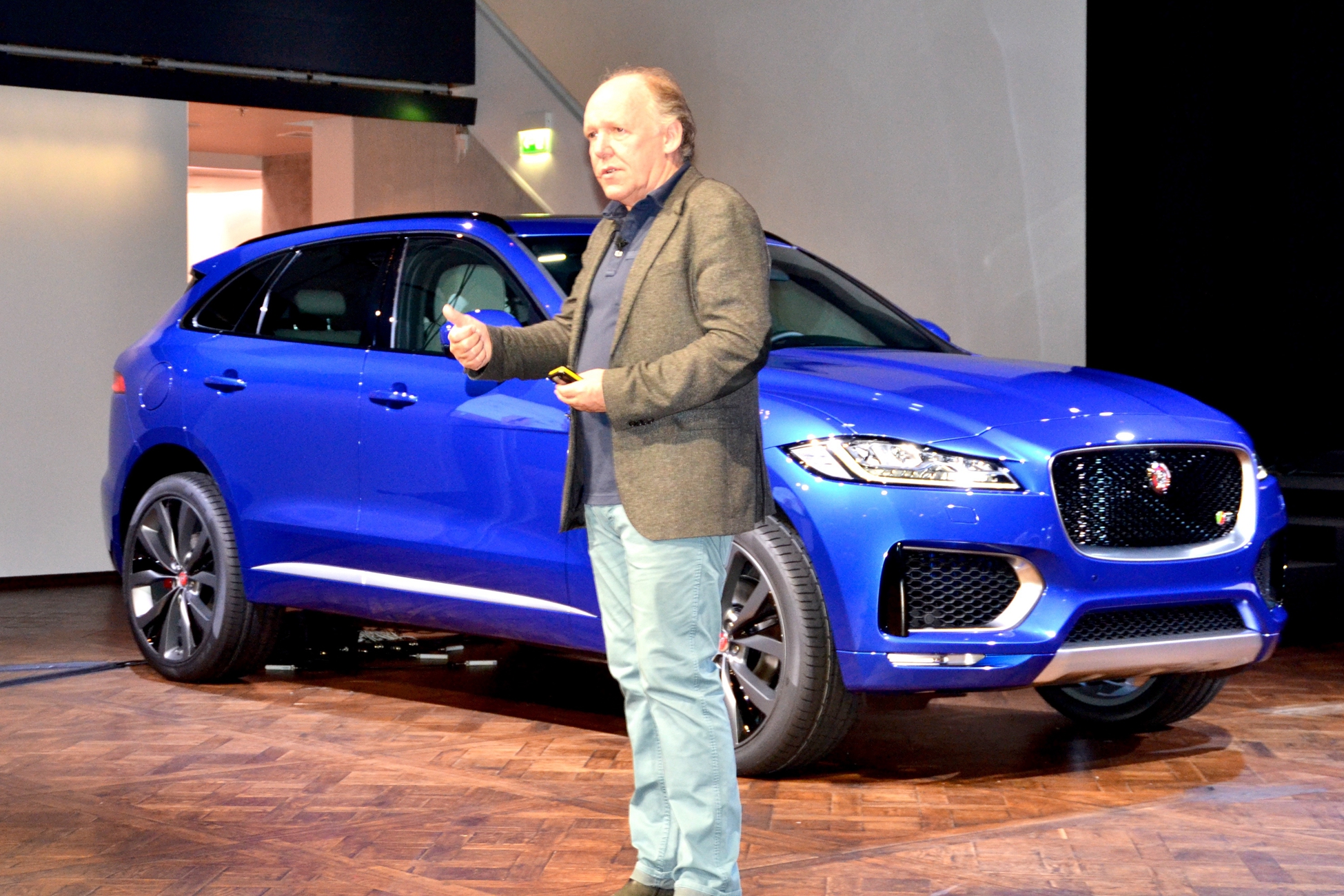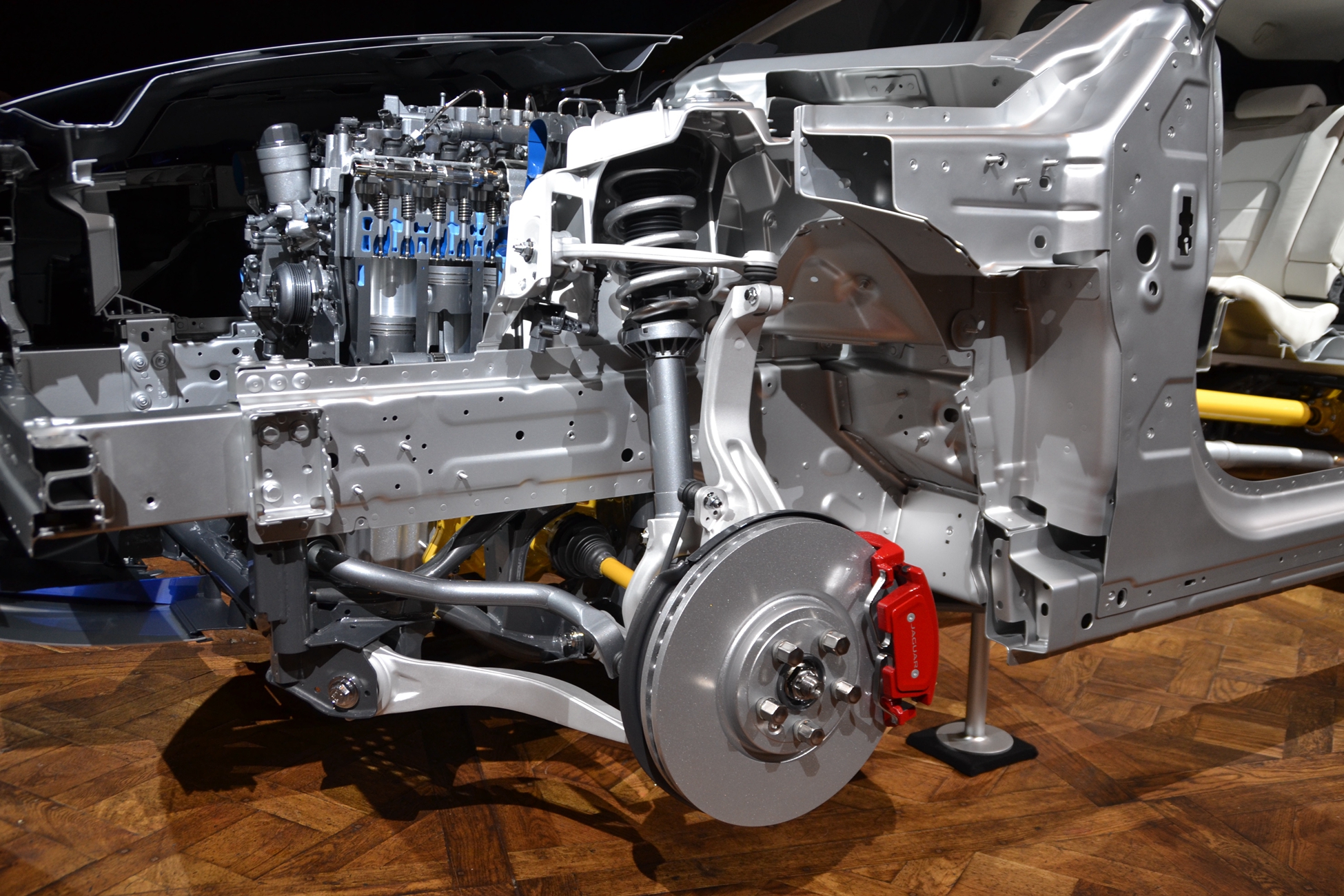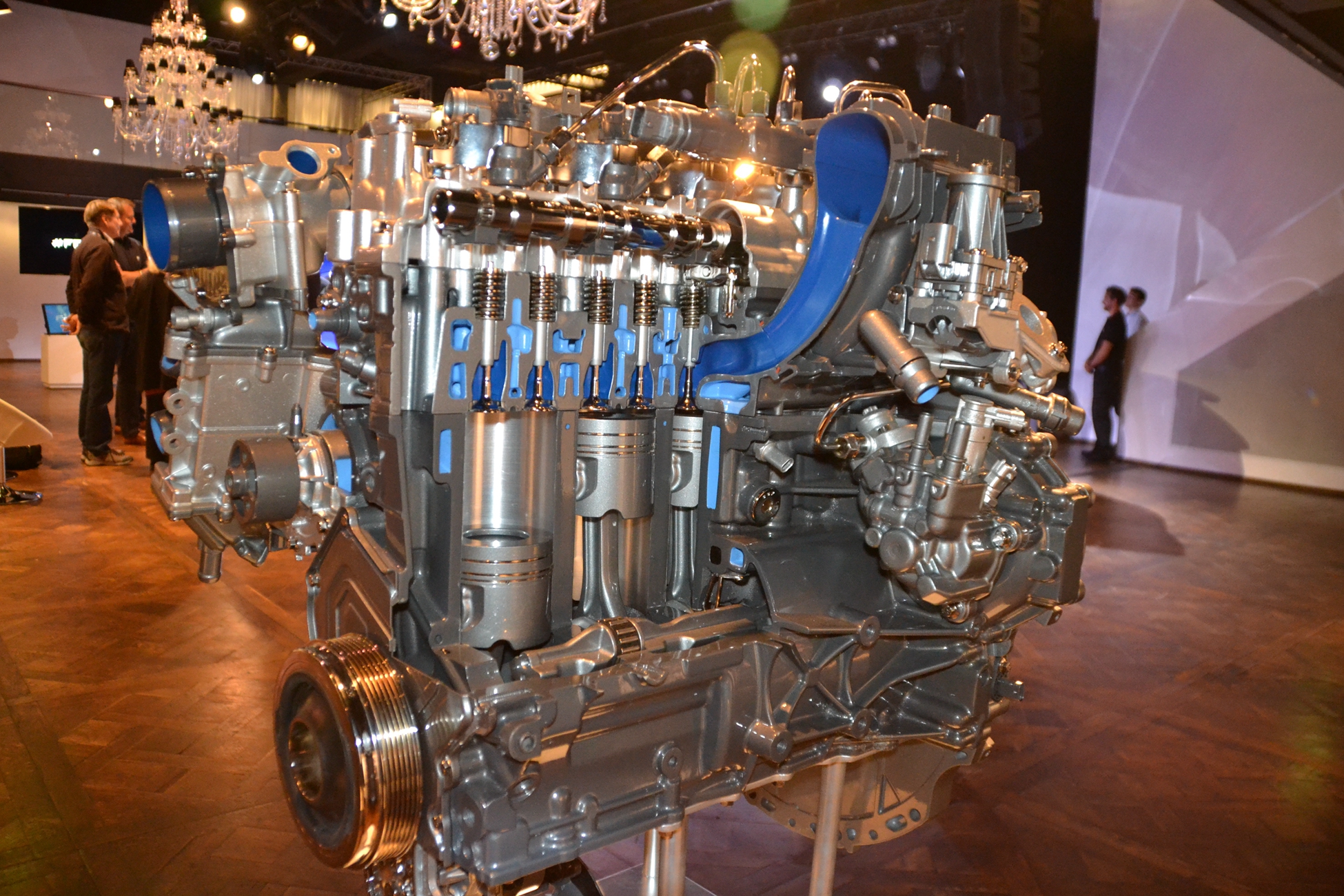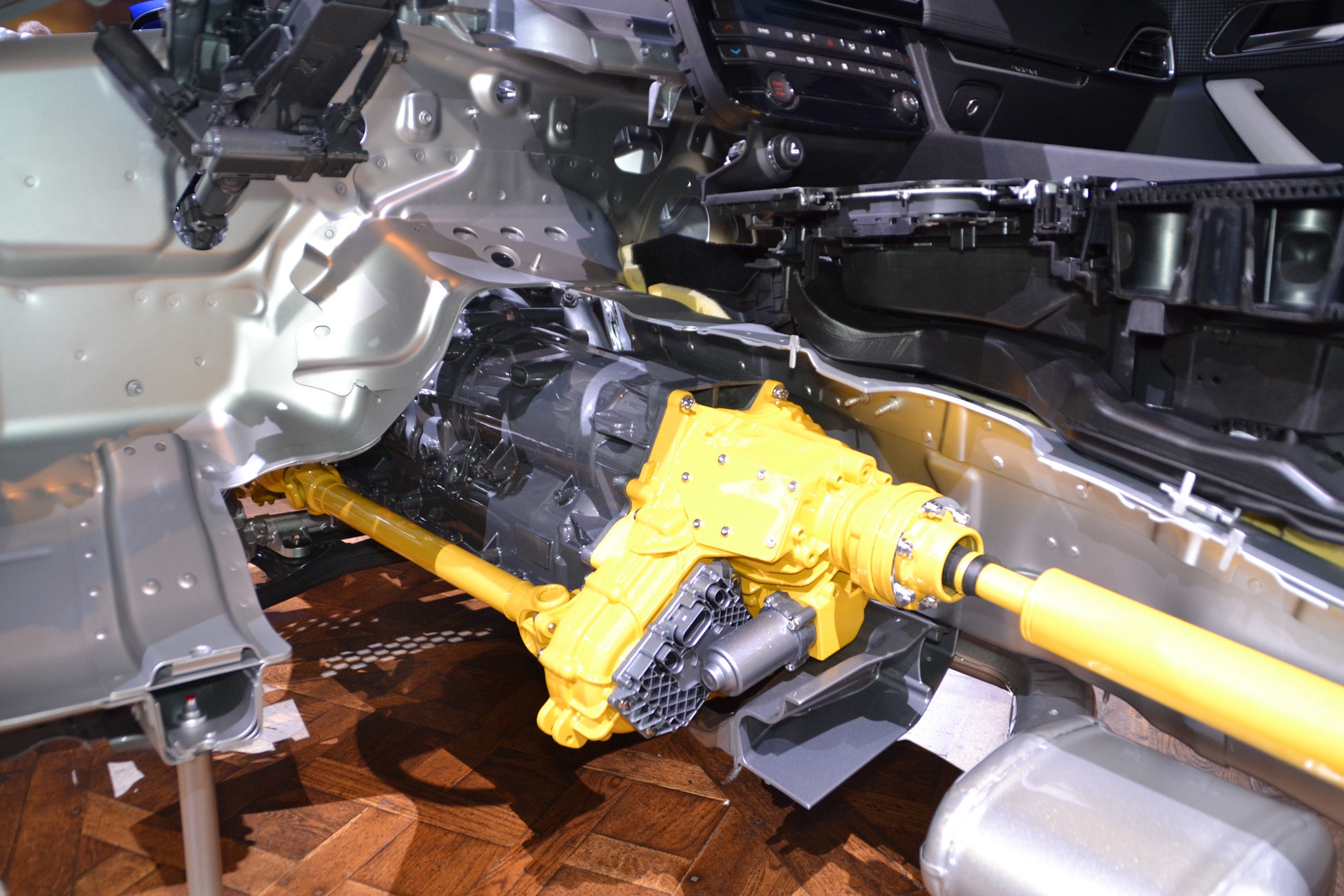 捷豹设计总监Ian Callum在法兰克福车展上介绍F-Pace。
捷豹设计总监Ian Callum在法兰克福车展上介绍F-Pace。 80%的F-Pace车身重量都是由铝合金制作而成,连悬架铸件和B柱等部件也使用了铝合金。
80%的F-Pace车身重量都是由铝合金制作而成,连悬架铸件和B柱等部件也使用了铝合金。 登陆美国市场的第一批F-Pace将搭载捷豹的2.0-L Ingenium涡轮柴油四缸发动机。
登陆美国市场的第一批F-Pace将搭载捷豹的2.0-L Ingenium涡轮柴油四缸发动机。 安装BorgWarner全轮驱动分动器的版本只比双驱版重了8 kg。
安装BorgWarner全轮驱动分动器的版本只比双驱版重了8 kg。 捷豹与SuperAlloy和Pirelli分别合作研发了F-Pace的车轮与轮胎,为边缘刮擦问题提供解决方案。
捷豹与SuperAlloy和Pirelli分别合作研发了F-Pace的车轮与轮胎,为边缘刮擦问题提供解决方案。
消费者对捷豹标志性轿跑、跑车和轿车的兴趣日减,导致其市场份额走低。为了挽救这一局面,捷豹决定涉足急速发展的跨界SUV市场。在2015法兰克福车展上亮相的2016 F-Pace是一辆以铝合金为主要材料打造的“高性能跨界SUV”,捷豹称其为一辆适应全天候、偏公路用途的房车,不仅可以轻松驾驭公路,而且还能征服那条著名的卢比肯小道。
2016 F-Pace在理念上非常接近于保时捷的人气车型Macan,捷豹正是以它为基准来设计F-Pace的。捷豹将F-Pace的基底称为“轻型铝合金架构”,同样适用该架构的还有XE和XF轿车。“我们知道,人们经常把保时捷的Macan作为这一级别的参照车”,捷豹汽车项目主管Andy Whyman表示。
捷豹不愿使用“平台”这个词,因为它往往暗示着与其他车型共享部件,而F-Pace上81%的内容都和另外两辆轿车不同。Stride表示,铝合金占据了整车重量的80%,多于其他任何跨界SUV。通常使用抗冲击高强度钢材的地方都使用了高强度铝合金,包括B柱和门板周围的冲压件。冲击塔则是用高压压铸铝合金制成。
捷豹自豪地表示,F-Pace中使用的1/3铝合金都是回收材料,而且它还打算在2020年前将这一比例提升至75%。这意味着目前捷豹每年对3万吨的铝进行重复利用。需要指出的是,这些回收的铝材料都是捷豹冲压工厂中生产的废料铝,并不是说那些用完的啤酒罐找到了一个高级的归宿。
那是因为F-Pace中使用的大多数铝合金都是一种符合RC5754级别的专用铝,由捷豹与Novelis 共同研发,具备特殊的强度特性。“我们正在研究对消费后产品加以利用,” Whyman表示。底板冲压件似乎最适合用这些回收材料制作,“因为啤酒罐的材料和底板很接近”。而用于车身结构的铝合金则全是高强度制品。
其他创新材料包括在前车架横向构件与仪表板横向构件中使用的镁。而后车厢则是用复合材料制作的。最终形成的白车身重量为298 kg(657磅),与体型小得多的菲亚特500 L相当。
Whyman表示,通过10万小时的计算机模拟与1.5万小时的结构工程制作,捷豹完成了F-Pace的设计优化,前端与后端的横向硬度分别比Macan高出50%和35%。
在转向方面,F-Pace使用博世汽车操纵系统公司(Bosch Automotive Steering)生产的可变速率电子助力转向系统,捷豹还专门为其设计了一套软件。上述车身硬度与这套软件共同实现了F-Pace干脆利落的转向反应。
前悬架是双叉骨结构,后悬架是捷豹称之为“一体化连接式的”双叉骨,上面的脚轮设计可以在急刹车的时候帮助车身稳定,Whyman表示。不仅如此,它还能在纵向上增强缓冲能力,抵御坑洼等障碍物造成的尖锐冲击。减震器由Bilstein公司生产。还有一个使用铝合金的部位是前转向节,使用铸铝模锻造工艺制作而成,因而具备极高的硬度。
F-Pace上市时将提供5种发动机选项,其中3种将用于美国市场。它们分别是一台180-PS (132-kW) 2.0-L涡轮柴油四缸发动机、一台340-PS (250-kW) 3.0-L增压汽油V6发动机以及同款发动机的380-PS (270-kW)版本。
Ingenium生产的柴油发动机中采用了可变排气凸轮正时技术,可在车辆冷启动时对后处理系统中的尾气迅速加热。在一个独立的冷却系统、一台可变水泵和一个恒温器的作用下,发动机自身也能实现快速升温。一个冷却低压EGR系统可配合1800巴(26.1 ksi)的共轨喷射系统和可变速率涡轮增压器,共同降低氮氧化物的含量。
两台V6发动机与F系跑车中采用的一样,但新款经过了一些调整,可以使驾驶员更好地驾驭低速反应。除了美国市场的3台发动机外,国际市场上还将推出一台300-PS (220-kW) 3.0-L的双涡轮柴油V6发动机与一台功率尚未公布的涡轮增压2.0-L汽油四缸发动机。据捷豹的知情人士透露,汽油四缸发动机日后也将进入美国市场。
所有发动机都将搭配ZF八速自动变速箱,但在某些市场中,柴油四缸发动机还可以搭配一款六速手动变速箱。后轮驱动是柴油版F-Pace的标准配置,用户也可选择全轮驱动,而V6汽油发动机一律为全轮驱动。
F-Pace的BorgWarner全轮驱动系统是基于其他捷豹车型采用的系统改进而成的,新系统的重量精简了16%,内部损耗也降低了10%。全轮驱动版只比后驱版重8kg(18磅)。
车轮的尺寸从18到22英寸不等。SuperAlloy Industrial有限公司生产的22英寸车轮的轮胎壁比竞争车型更高,有助于抵挡日积月累的冲击。
F-Pace内部也充满了新技术,一台10.2英寸的触摸式信息显示屏和一块12.3英寸的仪表板由一个Intelquad内核处理器驱动,并配有一台60 GB的固态硬盘。这些硬件确保了按压、滑动和滚动等操作的迅速与敏捷,但捷豹同时也为具有17个扬声器的825 W音响系统保留了传统的音量控制旋钮。这与凯迪拉克和本田不一样,它们主要是通过触屏和方向盘来控制音量的。
F-Pace的所有系统部件都是通过千兆以太网连接起来的,而且它是第一辆采用这种技术的车型。之所以这样做可行,是因为F-Pace内置了手机上使用的Wifi功能,搭配的车顶天线使信号接收能力比手机还要好上30%。它最多可以同时支持8个无线设备的上联网。
这一手机联网功能还能让车主使用Apple iOS或谷歌安卓智能设备远程连接车辆,便于检查车门是否上锁、车窗是否打开、最近将车停在何处,以及燃油和挡风玻璃清洗液的剩余量等问题。他们还能使用app来完成为车辆解锁、启动发动机、接收报警装置传来的警报信息、远程重置等操作。
F-Pace还有一个名为主动钥匙(Active Key)的创新系统,它是一个由 Flextronics生产的RFID橡胶手环,车主可以像Fitbit健康追踪腕带一样佩戴该手环。车主可将贵重物品锁在车内,并通过将主动钥匙手环按压在F-Pace后方的捷豹徽章上来完成解锁。Delphi 车载系统会与被动式的手环主动联系,因此手环中没有需要充电的电池。
四缸柴油版F-Pace将于今年秋天登陆美国,汽油六缸发动机将于2016年上市。
作者:Dan Carney
来源:SAE《汽车工程杂志》
翻译:SAE 上海办公室
Jaguar enters performance crossover SUV segment
In a bid to combat flagging market share due to declining consumer interest in its signature coupes, roadsters, and sedans, Jaguar is making its first move into the booming market for crossover SUVs. The 2016 F-Pace, shown at the 2015 Frankfurt Motor Show, is an aluminum-intensive "performance crossover," Jaguar's term for an all-weather, on-road-focused wagon with real handling on pavement and no pretensions that it is meant to conquer the Rubicon Trail.
Philosophically, this is similar to Porsche's wildly popular Macan, a vehicle Jaguar used as a benchmark for the F-Pace. Jaguar calls its foundation the Lightweight Aluminum Architecture, which it shares with the XE and XF sedans. "We recognize that the dynamic benchmark in the segment is the Porsche Macan," acknowledged Vehicle Program Director Andy Whyman.
The company shies from the term "platform" with its implicit parts sharing because the F-Pace is 81% unique from its sedan siblings. The result is a vehicle that is 80% aluminum by weight, which is more than any other crossover SUV, said Kevin Stride, Jaguar XE Vehicle Line Director. Areas that are normally high-strength steel for its strength in crashes are high-strength aluminum in the F-Pace, including the B-pillar and the door-surround stamping. Shock towers are high-pressure die-cast aluminum.
Jaguar boasts that one-third of the aluminum used in the F-Pace is recycled, and the goal is to raise this portion to 75% by 2020. This currently amounts to 30,000 ton (27,200 t) of reused aluminum annually. It should be understood that this refers to the company's reuse of its own scrap aluminum from its stamping facility, and not to the notion that discarded beer cans have found a higher purpose.
That's because most of the aluminum used in the F-Pace is a very specific RC5754 grade developed with Novelis for its strength properties. "We are working on using post-consumer material," Whyman said. Floorpan stampings are the most likely application for such recycled metals, he said. "Beer cans are similar to floorpan material," he explained. The structural aluminum is all high-strength.
Other innovative materials include the use of magnesium for a front frame crossmember as well as the common dashboard crossmember. And the vehicle's rear hatch is composite. The resulting body-in-white weighs 298 kg (657 lb), a mass comparable to that of the much smaller Fiat 500L's.
With 100,000 h of computer simulation time and 15,000 h of engineering work in the F-Pace's structure, Jaguar has been able to optimize its design to produce a vehicle that is 50% stiffer than the Macan in lateral stiffness at the front end and 35% stiffer across the rear, according to Whyman.
This stiffness, along with Jaguar's own software for the Bosch Automotive Steering-sourced variable-ratio electric power steering system contributes to the F-Pace's crisp steering response, he said.
Front suspension is double-wishbone and the rear is what Jaguar terms an "integral link" double-wishbone design whose castor properties contribute to stability during hard braking, said Whyman. It also provides increased longitudinal compliance to cushion the blow from sharp-edged impacts such as potholes. Dampers are Bilsteinunits. Another aluminum application is for the front steering knuckles, which are forged from cast aluminum blanks for maximum stiffness.
At launch the F-Pace will offer five engines, three of which will come to the U.S. market; a 180-PS (132-kW) 2.0-L turbodiesel four-cylinder, a 340-PS (250-kW) 3.0-L supercharged gasoline V6, and a 380-PS (270-kW) version of the same engine.
The Ingenium diesel engine employs variable exhaust cam timing to quickly heat the exhaust aftertreatment system on cold starts. The engine itself also warms quickly thanks to a split cooling system, variable water pump, and a mapped thermostat. The 1800-bar (26.1-ksi) common-rail injection system and variable-ratio turbocharger are complemented by a cooled low-pressure EGR system to produce minimal NOx.
The gasoline V6 engines are the same as seen in the F-Type sports car, but tuned for more tractable low-rpm response. World markets also get a 300-PS (220-kW) 3.0-L twin-turbocharged diesel V6 and a turbocharged 2.0-L gasoline four-cylinder engine of unspecified output. Company sources indicate that the gasoline four-cylinder will come to the U.S. later.
All engines are matched to ZF eight-speed automatic transmissions, though a six-speed manual transmission is available with the diesel four-cylinder in some markets. Rear-wheel drive is standard for the diesel, with optional all-wheel drive and the gasoline V6 models are all-wheel drive only.
The F-Pace's BorgWarner all-wheel-drive system is an evolution of that seen on other Jaguar models, one that sees the weight trimmed by 16% and internal losses reduced by 10%. All-wheel-drive models weigh only 8 kg (18 lb) more than rear-drive ones.
Power reaches the road through wheels that are available in sizes between 18 and 22 in. The SuperAlloy Industrial Co. Ltd. 22-inch wheels wear tires with higher sidewalls than those on competitors' vehicles, helping shield them from increasingly common impact damage.
New technology abounds inside the F-Pace, where there is a 10.2-in touchscreen infotainment display and a 12.3-in instrument panel that are powered by an Intelquad-core processor with a 60-GB solid-state hard drive. This promises quick, responsive pinching, swiping and scrolling, but Jaguar has retained a familiar rotary knob for volume control for the 17-speaker, 825-W sound system, unlike the interface in Cadillac and Honda models that rely exclusively on touch surface inputs and steering wheel controls.
All of the system's components are connected via gigabit Ethernet networking, making the F-Pace one of the very first vehicles to employ this technology. This seems appropriate because the F-Pace has a built-in cellular Wifi capability using a roof-mounted antenna for 30% better reception than that of a handheld cell phone, the company said. It supports as many as eight connected wireless devices at a time.
This cellular connection also lets owners connect to their car remotely using AppleiOS or Google Android smart devices to check whether the doors are locked, whether any windows are open, where the F-Pace was last parked, and the levels of fuel and windshield washer fluid. They can use the app to lock or unlock the F-Pace, start the engine, receive alerts if the alarm is triggered, and reset it remotely.
An innovative new system called Active Key is a Flextronics-supplied rubber wristband RFID system that the driver wears like a Fitbit activity monitor. With it, the driver can lock keys and valuables in the car and unlock it by pressing the Active Key to the letter "J" in the F-Pace's rear Jaguar badge. A Delphi onboard system communicates with the passive Active Key, so there is no battery in the wristband to discharge.
Four-cylinder diesel F-Paces reach U.S. dealers this fall, with gasoline six-cylinders arriving in 2016.
等级
打分
- 2分
- 4分
- 6分
- 8分
- 10分
平均分
